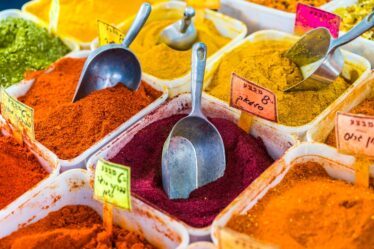
Pepper is a staple ingredient in kitchens around the world. It adds depth, complexity, and a hint of spice to a wide variety of dishes. From savory to sweet, pepper is a versatile spice that can elevate the flavor of any recipe. While many people are familiar with ground pepper, using whole pepper in your cooking can take your dishes to the next level. In this article, we will explore the benefits of using whole pepper, how to choose and store it for maximum flavor, the different types of whole pepper and their uses, and creative ways to incorporate it into your recipes.
Key Takeaways
- Using whole pepper in cooking adds depth and complexity to dishes
- Choose and store whole pepper in a cool, dry place for maximum flavor
- Different types of whole pepper, such as black, white, and pink, have unique flavor profiles and uses
- Whole pepper is generally preferred over ground pepper for cooking due to its fresher taste
- Grinding whole pepper at home allows for customization and freshness in dishes
The Benefits of Using Whole Pepper in Your Cooking
a. Health benefits of whole pepper: Whole pepper contains a compound called piperine, which has been shown to have numerous health benefits. It has anti-inflammatory properties, aids in digestion, and may even help with weight loss. Additionally, piperine has been found to enhance the bioavailability of other nutrients, meaning that it helps your body absorb more of the beneficial compounds from the foods you eat.
b. Enhanced flavor and aroma: When you grind whole pepper just before using it, you release its essential oils, which contain the spice’s distinct flavor and aroma. This results in a more intense and vibrant taste compared to pre-ground pepper. The freshness of whole pepper can make a noticeable difference in your dishes, adding complexity and depth that is hard to achieve with ground pepper.
c. Versatility in cooking: Whole pepper can be used in a variety of ways in your cooking. You can add it to marinades and rubs for meat and seafood, grind it into spice blends for seasoning vegetables or grains, or even use it as a finishing touch on top of dishes for an extra burst of flavor. Its versatility makes it a must-have ingredient in any kitchen.
How to Choose and Store Whole Pepper for Maximum Flavor
a. Tips for selecting high-quality whole pepper: When choosing whole pepper, look for peppercorns that are plump, firm, and free from any signs of moisture or mold. The color of the peppercorns can vary depending on the type, but they should be uniform in color and not have any discoloration or spots. It’s also a good idea to buy whole pepper from a reputable source to ensure its quality.
b. Proper storage techniques to maintain freshness: To keep your whole pepper fresh and flavorful, store it in an airtight container in a cool, dark place. Avoid storing it near heat sources or in direct sunlight, as this can cause the essential oils to evaporate and the flavor to diminish. Whole pepper can last for several years if stored properly, but its flavor will gradually fade over time, so it’s best to use it within a year for optimal taste.
The Different Types of Whole Pepper and Their Uses
| Type of Pepper | Color | Flavor | Uses |
|---|---|---|---|
| Black Pepper | Black | Sharp, pungent | Seasoning for meats, soups, stews, and vegetables |
| White Pepper | White | Mild, earthy | Used in light-colored dishes, such as cream sauces and mashed potatoes |
| Green Pepper | Green | Mild, slightly sweet | Used in salads, marinades, and sauces |
| Red Pepper | Red | Hot, spicy | Used in spicy dishes, such as chili and curry |
a. Overview of the different types of whole pepper: There are several types of whole pepper available, each with its own unique flavor profile. The most common types include black pepper, white pepper, green pepper, and pink pepper. Black pepper is the most widely used and has a robust, slightly spicy flavor. White pepper has a milder taste and is often used in dishes where the color of black pepper would be undesirable. Green pepper is harvested before it fully ripens and has a fresher, more herbaceous flavor. Pink pepper is not actually a true pepper but comes from a different plant species. It has a sweet and fruity taste.
b. Explanation of the unique flavor profiles and uses of each type: Black pepper is versatile and can be used in almost any savory dish, from soups and stews to grilled meats and roasted vegetables. White pepper is commonly used in creamy sauces, mashed potatoes, and light-colored dishes where the specks of black pepper would be visually unappealing. Green pepper adds a bright, fresh flavor to salads, stir-fries, and seafood dishes. Pink pepper is often used as a garnish or in desserts, where its fruity notes can complement sweet flavors.
Whole Pepper vs. Ground Pepper: Which is Better for Cooking?
a. Comparison of whole pepper and ground pepper: Whole pepper and ground pepper have different characteristics that can affect their use in cooking. Whole pepper is more aromatic and has a stronger flavor compared to ground pepper. It also retains its freshness and potency for longer since it is not exposed to air as much as ground pepper. On the other hand, ground pepper is more convenient to use and can be easily sprinkled or measured out in recipes.
b. Advantages and disadvantages of each form in cooking: The advantage of using whole pepper is that you have more control over the intensity of the flavor. By grinding it yourself, you can adjust the coarseness to your liking and release the essential oils at the last moment for maximum flavor. However, grinding whole pepper can be time-consuming and requires additional equipment. Ground pepper, on the other hand, is ready to use and can be added directly to dishes without any extra steps. However, it may lose its flavor more quickly and can sometimes have a slightly bitter taste.
Tips for Grinding Whole Pepper at Home

a. Step-by-step instructions for grinding whole pepper at home: To grind whole pepper at home, you will need a pepper mill or a mortar and pestle. Start by selecting the desired coarseness of your grind – finer for a more delicate flavor or coarser for a stronger taste. Fill the grinder or mortar with whole peppercorns, then grind or crush them until you achieve the desired consistency. It’s best to grind only what you need for immediate use to preserve the freshness of the flavor.
b. Equipment needed for grinding whole pepper: As mentioned earlier, a pepper mill or a mortar and pestle are the most common tools for grinding whole pepper. A pepper mill allows you to adjust the coarseness of the grind and is convenient for everyday use. A mortar and pestle, on the other hand, gives you more control over the texture and can be used for grinding other spices as well.
Creative Ways to Incorporate Whole Pepper into Your Recipes
a. Unique recipe ideas for using whole pepper in cooking: Whole pepper can be used in a variety of creative ways to add depth and complexity to your recipes. For example, you can infuse olive oil with whole pepper to create a flavorful base for dressings or marinades. You can also use whole pepper to make a spice rub for roasted vegetables or grilled meats. Another idea is to add whole pepper to a simmering pot of soup or stew and remove it before serving to impart a subtle spiciness.
b. Examples of unexpected flavor combinations: Whole pepper pairs well with a wide range of ingredients, both savory and sweet. For a unique twist on a classic dessert, try adding freshly ground black pepper to chocolate cake batter or sprinkling it on top of vanilla ice cream. In savory dishes, whole pepper can be combined with other spices like cumin, coriander, or cinnamon to create complex flavor profiles. Don’t be afraid to experiment and discover new flavor combinations that suit your taste.
Pairing Whole Pepper with Other Spices and Seasonings
a. Suggestions for pairing whole pepper with other spices and seasonings: Whole pepper can be paired with a variety of spices and seasonings to enhance its flavor and create interesting taste profiles. For example, combining whole pepper with garlic, thyme, and rosemary can add depth to roasted meats or vegetables. Mixing it with cumin, paprika, and chili powder can create a spicy rub for grilled chicken or shrimp. Whole pepper also complements other warm spices like cinnamon, nutmeg, and cloves in sweet dishes.
b. Explanation of how different spices and seasonings complement the flavor of whole pepper: The combination of spices and seasonings can enhance the flavor of whole pepper by adding complexity and balance. For example, garlic and thyme bring out the earthy notes of black pepper, while rosemary adds a hint of piney freshness. Cumin and paprika add warmth and depth to the spiciness of black pepper, while chili powder provides an extra kick. When paired with warm spices like cinnamon, nutmeg, and cloves, whole pepper can add a subtle heat and complexity to sweet dishes.
Using Whole Pepper in Marinades and Rubs for Meat and Seafood
a. Recipe ideas for using whole pepper in marinades and rubs: Whole pepper can be a key ingredient in marinades and rubs for meat and seafood. For a simple marinade, combine crushed whole peppercorns with olive oil, garlic, soy sauce, and a splash of lemon juice. Let the meat or seafood marinate for at least 30 minutes before cooking to allow the flavors to penetrate. For a spice rub, mix together ground whole pepper with other spices like paprika, cumin, coriander, and brown sugar. Rub the mixture onto the meat or seafood before grilling or roasting.
b. Explanation of how whole pepper enhances the flavor of meat and seafood: Whole pepper adds depth and complexity to meat and seafood dishes by providing a subtle spiciness that complements the natural flavors of the ingredients. The pungent aroma and intense flavor of freshly ground whole pepper can elevate even the simplest cuts of meat or fish. It also helps to tenderize the proteins in meat and seafood, resulting in a more flavorful and tender end product.
Whole Pepper in Vegetarian and Vegan Cooking: Ideas and Recipes
a. Recipe ideas for using whole pepper in vegetarian and vegan cooking: Whole pepper can add depth of flavor to vegetarian and vegan dishes, making them more satisfying and flavorful. For example, you can use whole pepper to season roasted vegetables, stir-fries, or grain-based salads. It can also be added to plant-based soups, stews, and curries to enhance the overall taste. Whole pepper pairs well with ingredients like mushrooms, lentils, chickpeas, and tofu, adding a subtle spiciness that complements their earthy flavors.
b. Explanation of how whole pepper can add depth of flavor to plant-based dishes: Plant-based dishes often rely on spices and seasonings to add depth and complexity to their flavors. Whole pepper can provide a subtle heat and spiciness that enhances the taste of vegetables, legumes, and plant-based proteins. Its aromatic qualities can bring out the natural flavors of these ingredients and make them more satisfying and enjoyable to eat.
Whole Pepper in Desserts: Surprising and Delicious Flavor Combinations
a. Recipe ideas for using whole pepper in desserts: While it may seem unconventional, whole pepper can add a unique twist to sweet dishes and desserts. For example, you can infuse cream or milk with whole pepper to create a subtly spiced base for custards or ice creams. You can also sprinkle freshly ground black pepper on top of fruit tarts or pies to add a hint of heat that balances the sweetness. Another idea is to combine whole pepper with other warm spices like cinnamon and nutmeg in baked goods like cookies or cakes.
b. Explanation of how whole pepper can add a unique twist to sweet dishes: The addition of whole pepper in desserts can create unexpected flavor combinations that are both surprising and delicious. The subtle spiciness of black pepper can balance the sweetness of desserts and add complexity to their flavors. When combined with other warm spices like cinnamon and nutmeg, whole pepper can create a warm and comforting taste profile that is perfect for fall and winter desserts.
In conclusion, using whole pepper in your cooking can elevate the flavor of your dishes and add a unique twist to your recipes. Its health benefits, enhanced flavor and aroma, and versatility make it a must-have ingredient in any kitchen. By choosing high-quality whole pepper and storing it properly, you can ensure that it retains its freshness and potency for longer. Whether you’re using it in marinades and rubs for meat and seafood, incorporating it into vegetarian and vegan dishes, or experimenting with it in desserts, whole pepper is a spice that can take your cooking to new heights. So go ahead, grab some whole pepper, and start exploring the endless possibilities it has to offer.
If you’re a fan of Pepper Whole, you’ll definitely want to check out this article on Flavorful Sips that features some healthy and delicious fruit candy recipes. These recipes are not only tasty but also a great way to satisfy your sweet tooth while incorporating the goodness of fruits. From homemade gummy bears to fruity lollipops, this article has it all. So, if you’re looking for a fun and nutritious treat, be sure to click on this link: https://flavorfulsips.com/healthy-and-delicious-fruit-candy-recipes/.



